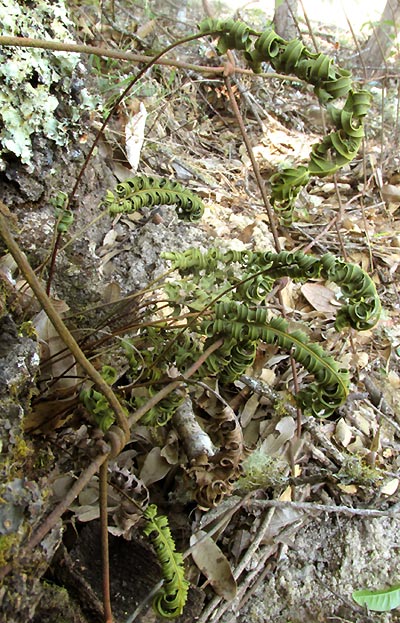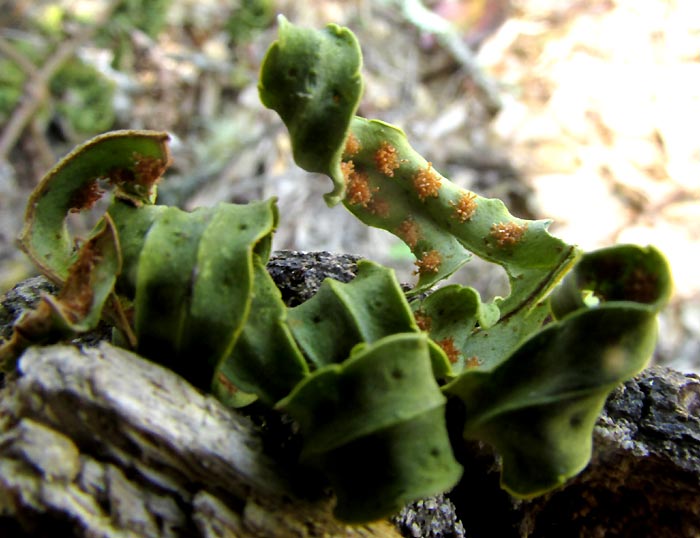Excerpts from Jim Conrad's
Naturalist Newsletter
entry from field notes dated April 16, 2022, taken in disturbed/reforesting borderline cloudforest within 1km of Valle de los Fantasmas, elevation ±2,320m (7600 ft), with limestone bedrock; about 40kms (24 miles), straight-line, ESE of San Luis Potosí, San Luis Potosí state, MÉXICO, (N22.06°, W100.62°)
"SIERRA MADRE POLYPODY"

On a limestone outcrop on a steep north-facing slope, the fern at the right was brittle and curled up, as all the ferns I'd seen here were, these days being the driest days of the late dry season. The fern was sheltering its spores and would open up to release them with the first rains. Despite the fronds contortions, I could see that it as a kind of polypody, for in the Kentucky of my childhood polypodies often were found in this kind of habitat. Still, I wanted to confirm that the spore-producing sori on the fronds' undersurfaces were polypody sori. To see them, I spit on a frond so it wouldn't crumble when I gingerly uncurled it and found what's shown below:

The brown spots are typical polypody sori, and at first I thought that North America's Common Polypody may have made its way down here. Fern spores are so tiny and light that sometimes they spread by wind to distant places. However, this fern shows certain small differences from that species, plus when I began the identification process I couldn't find documentation of North America's Common Polypody occurring in Mexico. So, similar Mexican ferns were sought.
Eventually POLYPODIUM MADRENSE turned up, endemic to Mexico and mostly documented in the high-elevation Trans-Mexican Volcanic Belt cutting east-west across Mexico with Mexico City at its center. However, also it'd been found as far south as Oaxaca, and as far north as Durango, so its presence in San Luis Potosí state is not out of the question. Nobody seems to call the species by the English name "Sierra Madre Polypody," but since its binomial is Polypodium madrense, I use it, but with quotation marks.
I wasn't the first to see this species' similarity to the Temperate Zone polypodies. In the 1852 book by expedition naturalist Berthold Seemann The Botany of the Voyage of H.M.S. Herald, under the Command of Captain Henry Kellett, R.N., C.B., During the Years 1845-51, freely available on the Internet, Seemann wrote that the species was similar to the European Common Polypody, but this species is "... readily known by the laciniae {frond divisions} being circinately rolled up {rolled up with the tip in the center}, the effect of a hygrometric property peculiar to this species, and apparently caused by the different contracting power of the thickened margin and {illegible} of the laciniae."
In the above picture you can see narrow thickening at the rim along the frond division margins, and that's what Seemann is referring to. Other features distinguishing this species from other polypodies is that the frond's lower surface is not heavily coated with silvery scales. A few scales can be seen but they're not conspicuous. Also, the outer ends of frond lobe margins show shallow indentations.
The rains surely will come soon. I'm looking forward to seeing ferns glorying in the moisture by unfurling to their full potential.